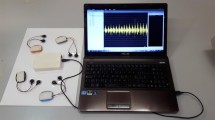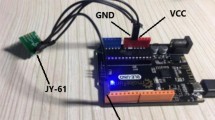Abstract
As people get interested in health issues, different types of human activity trackers or monitoring systems are emerging these days. Therefore, many researchers have been interested in this issue and have proposed various monitoring systems based on accelerometer sensors. However, few systems focus on energy consumption of sensor devices. In this paper, we focus on an application-level solution for saving energy consumption of a human daily activity monitoring system using a wireless wearable sensor. We propose an on-board data processing mechanism for monitoring daily activity in humans. This technique focuses on reducing the size of processed data and transmission rate to save the energy of the sensors. In addition, we develop an activity classification algorithm based on both an inclination angle and a standard deviation value. The proposed system is capable of monitoring most daily activities of the human body: standing, sitting, walking, lying, running, and so on. Furthermore, one of our key contributions is that all functionalities including data processing, activity classification, wireless communication, and storing classified activities were achieved in a single sensor node without compromising the accuracy of activity classification. Our experimental results show that the accuracy of our classification system is over 95 %.













Similar content being viewed by others
References
Culhane, K. M., Lyons, G. M., Hilton, D., Grace, P. A., & Lyons, D. (2004). Long term mobility monitoring of older adults using accelerometers in a clinical environment. Clinical Rehabilitation, 18(3), 335–343.
Gay, D., Levis, P., Behren, R., Welsh, M., Brewer, E., & Celler, D. (2003). The nesC language: A holistic approach to networked embedded systems. In Proceedings of the conference on programming language design and implementation (PLDI), pp. 1–11.
Hache, G., Lemaire, E., & Baddour, N. (2009). Development of a wearable mobility monitoring system. In Proceedings of Canadian medical and biological engineering conference, May 2009.
Hache, G., Lemaire, E., & Baddour, N. (2011). Wearable mobility monitoring using a multimedia smartphone platform. IEEE Transactions on Instrumentation and Measurement, 60, 3153–3161.
Karantonis, D. M., Narayanan, M. R., Mathie, M., Lovell, N. H., & Celler, B. G. (2006). Implementation of a real-time human movement classifier using a triaxial accelerometer for ambulatory monitoring. IEEE Transactions on Information Technology in Biomedicine, 10(1), 156–167.
Levis, P., et al. (2005). T2: A second generation OS for embedded sensor networks. Technical Report TKN–05–007.
Lyons, G. M., Culhane, K. M., Hilton, D., Grace, P. A., & Lyons, D. (2005). A description of an accelerometer-based mobility monitoring technique. Medical Engineering & Physics, 27(6), 497–504.
Mathie, M. J., Coster, A. C. F., Lovell, N. H., & Celler, B. G. (2003). Detection of daily physical activities using a triaxial accelerometer. Medical & Biological Engineering & Computing, 41(3), 296–301.
Najafi, B., Aminian, K., Paraschiv-Ionescu, A., Loew, F., Bula, C. J., & Robert, P. (2003). Ambulatory system for human motion analysis using a kinematic sensor: Monitoring of daily physical activity in the elderly. IEEE Transactions Biomedical Engineering, 50(6), 711–723.
Quwaider, M., Rao, J., & Biswas, S. (2010). Body-posture-based dynamic link power control in wearable sensor networks. IEEE Communications Magazine, July 2010.
Shimmer user manual, Available at http://www.shimmer-research.com.
Vaidya, S., Youn, J., Ali, H. (2010) Real-time fall detection and activity recognition using wireless sensors. In International conference on computer and software modeling (ICCSM 2010), Dec 2010.
Veltink, P. H., Bussmann, H. B. J., De Vries, W., Martens, W. L. J., & Van Lummel, R. C. (1996). Detection of static and dynamic activities using uniaxial accelerometers. IEEE Transactions on Rehabilitation Engineering, 4(4), 375–385.
Author information
Authors and Affiliations
Corresponding author
Rights and permissions
About this article
Cite this article
Choi, S., Yi, G. Energy Consumption and Efficiency Issues in Human Activity Monitoring System. Wireless Pers Commun 91, 1799–1815 (2016). https://doi.org/10.1007/s11277-016-3321-x
Published:
Issue Date:
DOI: https://doi.org/10.1007/s11277-016-3321-x




